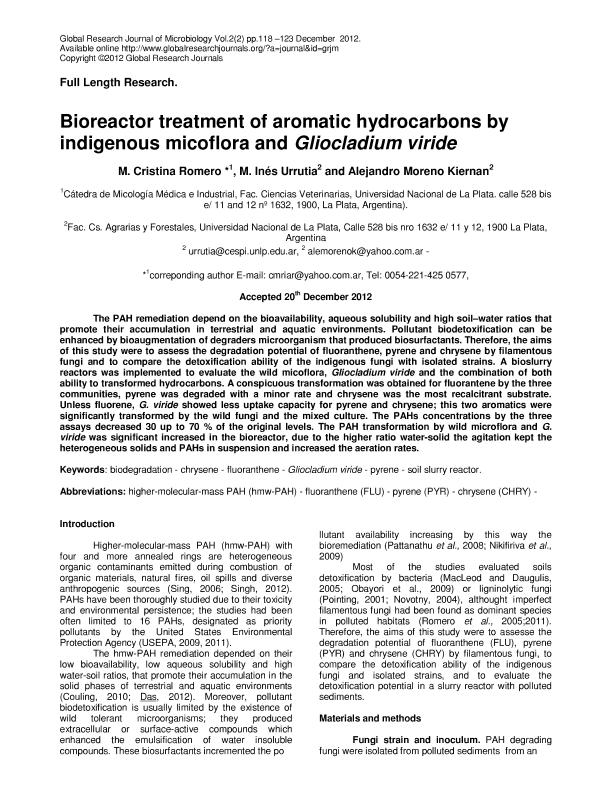Mostrar el registro sencillo del ítem
dc.contributor.author
Romero, Maria Cristina

dc.contributor.author
Urrutia, María Inés

dc.contributor.author
Moreno Kiernan, Alejandro Ricardo

dc.date.available
2023-05-30T19:39:56Z
dc.date.issued
2012-12
dc.identifier.citation
Romero, Maria Cristina; Urrutia, María Inés; Moreno Kiernan, Alejandro Ricardo; Bioreactor treatment of aromatic hydrocarbons by indigenous micoflora and Gliocladium viride; Global Research Journals; Global Research Journal of Microbiology; 2; 2; 12-2012; 118-123
dc.identifier.issn
2315-5094
dc.identifier.uri
http://hdl.handle.net/11336/199090
dc.description.abstract
The PAH remediation depend on the bioavailability, aqueous solubility and high soil–water ratios that promote their accumulation in terrestrial and aquatic environments. Pollutant biodetoxification can be enhanced by bioaugmentation of degraders microorganism that produced biosurfactants. Therefore, the aims of this study were to assess the degradation potential of fluoranthene, pyrene and chrysene by filamentous fungi and to compare the detoxification ability of the indigenous fungi with isolated strains. A bioslurry reactors was implemented to evaluate the wild micoflora, Gliocladium viride and the combination of both ability to transformed hydrocarbons. A conspicuous transformation was obtained for fluorantene by the three communities, pyrene was degraded with a minor rate and chrysene was the most recalcitrant substrate. Unless fluorene, G. viride showed less uptake capacity for pyrene and chrysene; this two aromatics were significantly transformed by the wild fungi and the mixed culture. The PAHs concentrations by the three assays decreased 30 up to 70 % of the original levels. The PAH transformation by wild microflora and G. viride was significant increased in the bioreactor, due to the higher ratio water-solid the agitation kept the heterogeneous solids and PAHs in suspension and increased the aeration rates.
dc.format
application/pdf
dc.language.iso
eng
dc.publisher
Global Research Journals
dc.rights
info:eu-repo/semantics/openAccess
dc.rights.uri
https://creativecommons.org/licenses/by-nc-sa/2.5/ar/
dc.subject
BIODEGRADATION
dc.subject
CHRYSENE
dc.subject
FLUORANTHENE
dc.subject
GLIOCLADIUM VIRIDE
dc.subject.classification
Biología Celular, Microbiología

dc.subject.classification
Ciencias Biológicas

dc.subject.classification
CIENCIAS NATURALES Y EXACTAS

dc.title
Bioreactor treatment of aromatic hydrocarbons by indigenous micoflora and Gliocladium viride
dc.type
info:eu-repo/semantics/article
dc.type
info:ar-repo/semantics/artículo
dc.type
info:eu-repo/semantics/publishedVersion
dc.date.updated
2023-05-29T12:39:11Z
dc.journal.volume
2
dc.journal.number
2
dc.journal.pagination
118-123
dc.journal.pais
Botsuana

dc.description.fil
Fil: Romero, Maria Cristina. Consejo Nacional de Investigaciones Científicas y Técnicas. Centro Científico Tecnológico Conicet - La Plata; Argentina. Universidad Nacional de La Plata. Facultad de Ciencias Veterinarias; Argentina
dc.description.fil
Fil: Urrutia, María Inés. Universidad Nacional de La Plata. Facultad de Ciencias Agrarias y Forestales; Argentina
dc.description.fil
Fil: Moreno Kiernan, Alejandro Ricardo. Universidad Nacional de La Plata. Facultad de Ciencias Agrarias y Forestales; Argentina
dc.journal.title
Global Research Journal of Microbiology
dc.relation.alternativeid
info:eu-repo/semantics/altIdentifier/url/http://globalresearchjournals.org/journal/grjm/archive/december-2012-vol-2(2)/bioreactor-treatment-of-aromatic-hydrocarbons-by-indigenous-micoflora-and-gliocladium-viride
Archivos asociados
